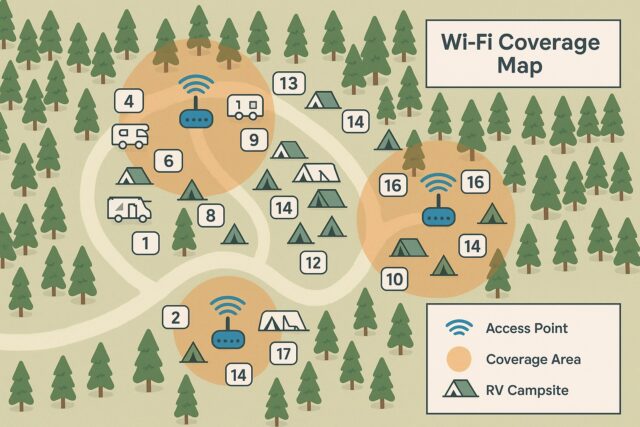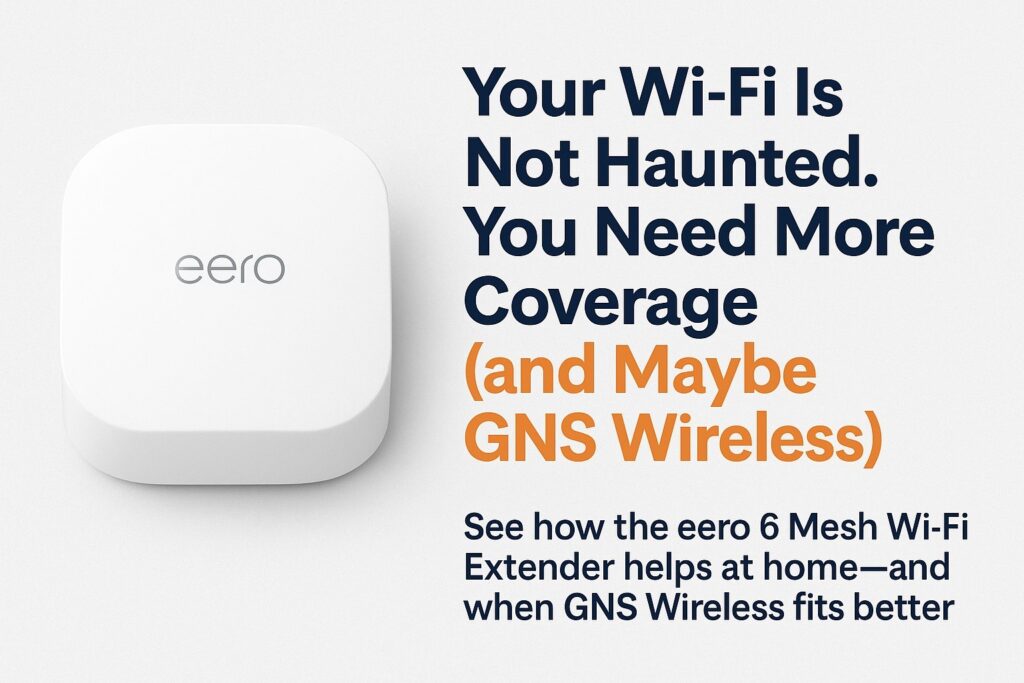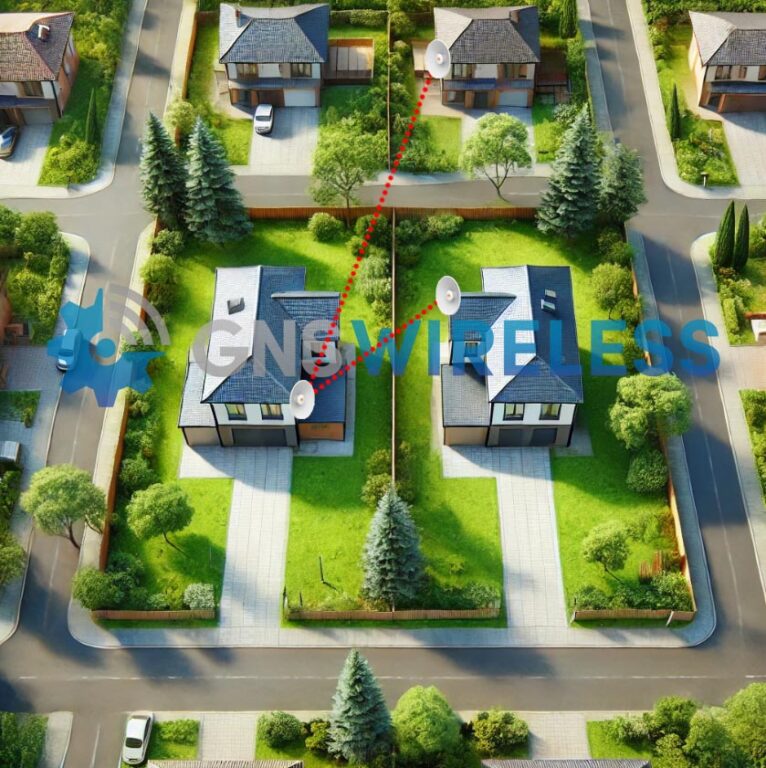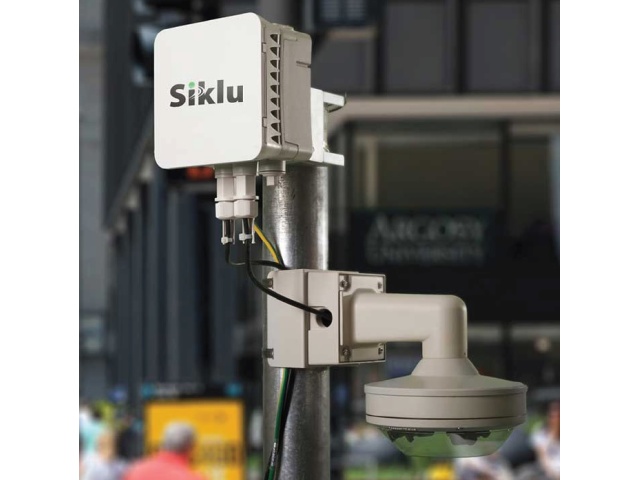Turn Great Stays into Rave Reviews with GNS Wireless
Outdoor adventure is booming in 2025. RV parks are full. Campgrounds are bustling. Marinas are thriving. But while people crave the outdoors, they expect one thing to stay connected: strong, reliable Wi-Fi.
Outdoor Wi-Fi for Campgrounds and Marinas
Whether it’s for remote work, streaming movies under the stars, posting that perfect sunset to Instagram, or checking weather updates, guests demand outdoor Wi-Fi. It’s no longer a luxury — it’s an expectation.
Without It?
Bad reviews. Lost bookings. Negative word-of-mouth. In a world where online ratings drive success, not offering reliable Wi-Fi could be costing you far more than you realize.
The Numbers Don’t Lie:
-
89% of travelers now consider Wi-Fi “essential” when choosing accommodations (source: Booking.com 2024 survey).
-
61% say they’d leave a negative review if Wi-Fi was poor.
-
73% of guests would extend their stay if the Wi-Fi met or exceeded their expectations.
Why GNS Wireless?
At GNS Wireless, we specialize in custom Wi-Fi solutions built specifically for RV parks, campgrounds, and marinas. Here’s why park owners across the U.S. trust us:
-
Free Site Surveys and Heat Mapping: We design a solution that fits your location, not a cookie-cutter package.
-
Outdoor-Rated Equipment: Built tough to handle rain, heat, salt air, and everything in between.
-
Seamless Guest Experience: Reliable signal coverage, even across large areas and waterfronts.
-
Proven Success: 20+ years of experience bringing outdoor Wi-Fi to life.
Real-World Success:
Last year, Seaside Harbor Marina in Florida struggled with constant guest complaints about Wi-Fi dead zones. After partnering with GNS Wireless, we implemented a custom wireless mesh system with dock-to-clubhouse coverage. Within 90 days, their guest satisfaction scores rose by 34%, and their seasonal bookings jumped 18%.
“We went from dreading tech complaints to hearing ‘Best marina Wi-Fi ever!’ almost every week.” — Dave W., Marina Owner
Visual Example:
Common Questions About Campground Wi-Fi:
Q: How long does a campground Wi-Fi installation take? A: Most installations are completed in as little as 2-4 days, depending on the size and complexity of your site.
Q: Is your Wi-Fi equipment waterproof and weather-resistant? A: Absolutely. All GNS Wireless outdoor systems are designed to withstand rain, heat, salt air, and extreme temperatures.
Q: Will I need a dedicated internet connection for my park? A: In most cases, yes. We can help evaluate your options and ensure bandwidth is distributed efficiently across your property.
What You Could Be Offering Your Guests:
-
High-speed internet for streaming, remote work, and online bookings.
-
Secure, managed networks with branded guest login portals.
-
Reliable connectivity for mobile apps, digital maps, payments, and smart devices.
Don’t Let Connectivity Hold Your Business Back.
✅ Get a Free Wi-Fi Site Survey Today!
Visit GNSWireless.com or call 877-209-5152 to speak with a Wi-Fi expert. We’ll help you design a custom, affordable solution — and help you turn good stays into great reviews.
✨ BONUS: Ask about our FREE “Campground Wi-Fi Readiness Checklist” and start planning your upgrade!
GNS Wireless | Outdoor Wi-Fi Experts | 20+ Years Strong
#CampgroundWiFi #OutdoorInternet #MarinaWiFi #GNSWireless #WiFiSolutions2025
Learn more:
-
Wi-Fi for campgrounds 2025
-
Marina Wi-Fi solutions
-
Outdoor wireless networks for parks
-
Campground guest Wi-Fi systems
-
RV park Wi-Fi installation
-
Outdoor Wi-Fi access points
-
Reliable campground internet
-
Free Wi-Fi survey for marinas and campgrounds
🧠 Your Wi-Fi Is Not Haunted. You Just Need Better Coverage (and Maybe GNS Wireless)
Let’s paint a picture: You’re standing in your kitchen, coffee in hand, trying to stream a video or check emails. The Wi-Fi drops. Again.
You take a deep breath, walk three feet into the hallway—boom. Internet’s back. Take one step back—dead zone. What is this, a tech poltergeist?
Spoiler: it’s not ghosts. It’s your Wi-Fi. More specifically, your Wi-Fi coverage.
And that’s where the eero 6 Mesh Wi-Fi Extender comes in.
See below for eero 6 mesh Wi-Fi extender setup help
🏡 What the Heck Is an eero 6 Mesh Extender—and Why Does It Work?
In short: the eero 6 is like a loyal sidekick for your main router. It takes the signal from your existing eero system and stretches it further, giving you up to 1,500 sq. ft. of extra coverage with the latest Wi-Fi 6 technology.
No more buffering in the bathroom. No more Zoom calls from the garage that sound like you’re on the moon.
✨ What Makes It Awesome?
-
Plug it in. That’s literally it.
-
Works with Alexa (ask her to reboot your network hands-free)
-
Dual-band Wi-Fi 6 = smoother streams, faster uploads, and more devices supported
-
Self-updating firmware to keep things secure and snappy
It’s sleek. It’s affordable. And for the average household with a few dead spots—it’s a total game changer.
⚠️ But Here’s the Catch: Not Everything Can Be Fixed with a Plug-In Box
Let’s be real—not every Wi-Fi problem lives inside your house.
You can stack 10 eero 6s like Jenga blocks and still not get a signal out to:
-
Your detached workshop
-
The barn out back
-
The RV parked 500 feet away
-
That fancy new pool cabana you built for “remote work” (we see you…)
“I tried extending Wi-Fi to my guest house with a mesh system. Let’s just say my guests now bring data plans.” – Actual customer before calling GNS Wireless
This is where consumer mesh systems hit their limit—and where GNS Wireless steps in like the tech cavalry.
🧭 So… Who’s GNS Wireless and Why Should I Care?
We’re the people who fix the Wi-Fi problems you can’t fix with a gadget from Amazon.
Commercial-grade solutions. Rugged outdoor access points. Wireless bridges that shoot internet across fields, rivers, and even parking lots.
You’ve got a farm, RV park, marina, warehouse, or multi-building setup? We’ve got the blueprint, the hardware, and the tech support to bring the internet anywhere you need it.
Real Talk:
-
Trying to get internet from your house to a garage 900 ft away?
→ You need a Point-to-Point Wireless Bridge, not an eero. -
Want your campground guests to stream Netflix from their tents without rage-quitting?
→ You need outdoor Wi-Fi access points, weatherproof enclosures, and PoE kits. -
Looking for a plug-and-play system that actually works out-of-the-box?
→ We’ll preconfigure it before it ships.
🧰 eero 6 vs. GNS Wireless — Which One Do You Need?
| Situation | eero 6 Mesh Extender | GNS Wireless Solution |
|---|---|---|
| Wi-Fi dead spots in your home | ✅ Perfect fit | 🚫 Overkill |
| Internet to a guest house 800ft away | 🚫 Nope | ✅ Wireless Bridge |
| Outdoor Wi-Fi for RV parks or marinas | 🚫 Nope | ✅ Hardened Access Points |
| Need help planning and installing? | ❌ You’re on your own | ✅ We help you plan it all |
📞 Still Not Sure? Let’s Chat.
Whether you’re dealing with a frustrating dead zone in your home, or you’re trying to beam fast internet to a metal building a quarter-mile away—you’ve got options.
➡️ Start simple with an Amazon eero 6 for indoor fixes.
➡️ But when it’s bigger, more rugged, and way more important—that’s a job for GNS Wireless.
📧 support@gnswireless.com
📞 877-209-5152
🔗 See Outdoor Wi-Fi Solutions »
✨ Final Thought: Wi-Fi Problems Don’t Fix Themselves
It’s easy to blame the weather, your ISP, or your dog chewing on a cable. But the truth is: coverage, equipment, and planning matter.
The eero 6 Mesh Wi-Fi Extender is a smart start.
But when you want something stronger, longer range, and built for the outdoors, GNS Wireless has your back.
Let’s get your whole property online—not just the living room.
How we can help:
-
best Wi-Fi extender for dead zones
-
how to extend Wi-Fi to garage or barn
-
mesh Wi-Fi vs point-to-point wireless
-
improve Wi-Fi in detached building
-
GNS Wireless outdoor Wi-Fi solutions
-
eero 6 setup and alternatives for large properties
-
Wi-Fi for campgrounds and outdoor spaces
“No trenching, no limits—just fast, wireless freedom.”
Imagine beaming high-speed internet across your property—shop to house, barn to home, warehouse to office—without running a single cable. That’s the magic of a point-to-point wireless bridge.
Whether you’re a business owner, tech DIYer, or just tired of weak Wi-Fi in your outbuilding, this guide breaks it down simple, fast, and clear—and shows you how to pick the right point-to-point wireless bridge system for your needs.
What Is a Point-to-Point Wireless Bridge?
A point-to-point (P2P) wireless bridge connects two locations wirelessly, often hundreds to thousands of feet apart. Instead of laying Ethernet cable underground (which can cost thousands), a wireless bridge beams your internet signal over the air.
-
🎯 Perfect for connecting buildings on the same property with a wireless bridge
-
🌲 Works across fields, driveways—even through trees, with the right gear
-
⚡ Speeds up to 2 Gbps with high-throughput wireless bridge kits
-
🔒 Encrypted and secure point-to-point communication
✅ Use it when: You have internet at one location and need it somewhere else—without digging or running fiber.
Looking for a cost-effective way to share internet between buildings? A point-to-point wireless bridge from GNS Wireless is the answer.
When Should You Use a Wireless Bridge?
-
Sharing internet from your home to a detached garage or shop
-
Connecting multiple buildings on a farm, school campus, RV park, or business complex
-
Running IP security cameras across wide outdoor spaces
-
Avoiding ISP contracts or installation in rural zones with no service
Need help designing a point-to-point wireless bridge solution for your location? 📞 Call 877-209-5152 or contact us.
📈 Which Wireless Bridge Is Right for You?
| Model | Range | Obstruction Tolerance | Max Speed | Best For |
|---|---|---|---|---|
| GNS-1163AC | Up to 300ft | Clear Line of Sight | 300+ Mbps | Budget-friendly, short-range links |
| GNS-1153AC | Up to 500ft | Handles light foliage | 450 Mbps | Small campuses, trees in the way |
| GNS-1155AC | 1,000–3,000ft | Mid-range obstructions | 750+ Mbps | Barns, shops, industrial buildings |
| GNS-5660 | Up to 1,500ft | Requires clear LOS | Up to 2 Gbps | High-speed streaming, data transfer |
📞 Call 877-209-5152 for free help choosing the right model for your point-to-point bridge installation.
🛠️ Real Customer Success Stories
🧰 “From Barn to Office—Without Breaking Ground”
“We couldn’t run fiber to our barn, and cellular was a joke. The GNS-1155AC saved the day—fast internet, zero digging. We’re running Zoom, cameras, everything.”
— Mike S., North Carolina
📸 “Security Cameras in the Field”
“We used the GNS-1153AC to link our shop to a remote camera pole. Even with trees, the connection is solid. Installation took less than 2 hours.”
— Lisa G., Oregon
🏧 “Factory Expansion, No Fiber Delay”
“The GNS-5660 gave us a 2 Gbps backbone between buildings—blows away what we had before.”
— Raj T., Texas
❓ Frequently Asked Questions
✅ Will a wireless bridge work through trees or buildings?
Some models (like GNS-1153AC) can handle minor obstructions. For best performance, clear line of sight is ideal.
✅ Do I need to configure it?
GNS Wireless bridges are pre-configured—just mount, power up, and aim.
✅ Is it secure?
Yes—AES encryption, MAC filtering, and hidden SSID options make it safer than many public Wi-Fi setups.
✅ Can I extend internet between buildings with no cable?
Yes! That’s exactly what a point-to-point wireless bridge is for. Whether it’s a shop, barn, garage, or security camera, GNS has you covered.
🚀 Why Wireless Bridges Outperform Mesh and Extenders
| Feature | Wi-Fi Extender | Mesh Network | Wireless Bridge |
| Speed | Low | Medium | ✅ High (Gigabit+) |
| Reliability | Spotty | Good | ✅ Excellent |
| Setup Range | 50–150 ft | 100–300 ft | ✅ 300–3,000+ ft |
| Cost-Effective | ❌ | ❌ | ✅ Yes |
Looking for the best alternative to mesh Wi-Fi? A point-to-point wireless bridge system delivers true long-range, high-speed results.
🚪 Get Connected Today
🛒 Ready to beam internet across your property?
➡️ Shop Wireless Bridge Kits
📞 Talk to an expert:
877-209-5152 — get help in minutes, not hours.
📩 Not sure which model is right?
Contact GNS Wireless or drop a message below.
💬 Already using a wireless bridge?
Share your success story in the comments or tag us on Instagram for a chance to be featured!
If you’re working with the GNS-5660, a pre-configured high-speed 60 GHz wireless bridge using MikroTik nRAY60, here’s how to properly change the IP address for each radio.
While Quick Set might be the first screen you see after logging into the Mikrotik nRay60, do not use it to change IP addresses. Instead, always make IP modifications through WebFig > IP > Addresses. This ensures the settings are correctly applied and don’t conflict with routing or bridge configurations.
Default Login & IP Address Info (Pre-Configured)
Each GNS-5660 bridge kit from GNS Wireless ships pre-configured:
-
Source Bridge IP:
192.168.1.251 -
Remote Bridge IP:
192.168.1.252 -
Username:
admin -
Password:
Admin1234
Step-by-Step: Changing the IP Address
-
Login via WebFig
Connect to the GNS-5660 bridge via Ethernet. In your browser, go to:-
http://192.168.1.251for the source unit -
http://192.168.1.252for the remote unit
Use the login:
-
Username:
admin -
Password:
Admin1234
-
-
Enter WebFig (Not Quick Set)
Once logged in, click “WebFig” in the top menu to access advanced settings. -
Navigate to IP Settings
On the left menu, go to:
IP > Addresses -
Edit the IP Address
-
Click the pencil icon next to the current IP to change it
-
Example:
192.168.10.1/24onether1 - Leave the Interface default as bridge.
- Change the Network to match your Subnet range
-
-
Apply and Save
Click Apply, then OK to save your changes. -
Reconnect Using the New IP
Your session may end—log back in using the new IP address.
Why Use WebFig Instead of Quick Set?
Quick Set is a simplified setup wizard. But for advanced devices like the nRAY60, using Quick Set can lead to partial settings changes, which may cause connection issues or routing conflicts. WebFig gives you full control and applies changes properly across all system layers.
Need Pre-Configured Wireless Bridge Kits?
The GNS-5660 is pre-tested and ready to install. Just mount, align, and go—no complicated setup required.
✅ Speeds up to 2 Gbps
✅ Secure 60 GHz connection
✅ 1000+ ft range
✅ Perfect for barns, shops, or campground expansion
📞 Contact Us for a Quote: 877-209-5152
📧 Email: support@gnswireless.com
🌐 Visit: www.gnswireless.com
Today’s campers aren’t just bringing marshmallows and trail mix—they’re bringing iPads, Firesticks, and PS5s. Whether they’re on a Netflix binge under the stars or gaming in a tent, your Wi-Fi is under constant pressure. 😩
As a campground owner, you have to offer Wi-Fi to stay competitive. But without proper controls, a single user can tank your network—or worse, download something shady that puts you on the hook. That’s where GNS Wireless comes in. We offer Campground Wi-Fi Solutions that are tailor made for your park.
Let’s break down how to level the playing field and give every camper a fair (and secure) shot at the internet.
🚨 The Problems: Bandwidth Hogs & Legal Nightmares
A typical camper these days may be:
-
Streaming in HD on Netflix, Hulu, Amazon Prime
-
Using Firesticks and Smart TVs
-
Gaming online or downloading huge updates
-
Running multiple connected devices per person
Without bandwidth control and security features:
-
⚠️ One camper can slow the network for everyone
-
⚠️ Illicit downloading exposes you to legal risks
-
⚠️ Poor Wi-Fi = angry reviews and lost reservations
✅ The GNS Wireless Solution: Smart, Scalable Wi-Fi That Works
We specialize in high-performance Wi-Fi for outdoor environments—especially campgrounds, RV parks, marinas, and state parks. Here’s how we help:
🔌 GWN-7003-9P Gigabit Router
-
Built-in bandwidth control prevents hogging
-
Includes firewall and content filtering
-
Full cloud management so you can monitor activity and adjust settings anytime
📶 GNS-7664-ELR Wi-Fi 6 Outdoor Access Point
-
Wi-Fi 6 = faster speeds + more capacity
-
Handles dozens of devices per site
-
IP67-rated for harsh outdoor environments
📦 Hotspot & Access Point Packages
-
Pre-configured packages for RV parks, cabins, tent sites
-
Flexible range from single APs to multi-site mesh
🛡️ Weatherproof Enclosures
-
Keep your access points and routers protected
-
Options with vents, heating, cooling, and power (120V, 220V)
-
Ideal for pole-mounting or outbuildings
🎯 Custom Solutions for Every Campground
No two properties are the same, and cookie-cutter systems just won’t cut it. That’s why GNS Wireless offers:
💡 Free Site Survey & Heat Mapping
We analyze your layout, trees, terrain, and guest usage patterns to build a Wi-Fi heatmap showing where signal strength matters most.
📝 Line-Item Quote
You’ll get a detailed quote with exactly what gear you need—no guesswork, no fluff, and solutions for:
-
Expanding coverage
-
Preventing abuse
-
Keeping your network secure
📞 Ready to Fix Your Wi-Fi?
Don’t let your campground’s internet be the next horror story on Google Reviews. Let GNS Wireless build you a secure, reliable, and fair Wi-Fi network your guests will rave about.
👉 Request Your Free Site Survey & Custom Quote Now
Featured Products:
What we offer:
-
best Wi-Fi solution for campgrounds
-
how to manage campground internet
-
prevent bandwidth abuse at RV parks
-
Wi-Fi for outdoor venues and campgrounds
-
secure campground Wi-Fi network
-
limit internet usage in RV parks
-
firewall for campground Wi-Fi
-
outdoor Wi-Fi access points for campgrounds
-
weatherproof router enclosures for outdoor Wi-Fi
-
campground Wi-Fi with bandwidth control
-
Wi-Fi 6 access points for RV parks
-
custom campground Wi-Fi network design
-
free Wi-Fi heat mapping for campgrounds
-
campground internet management solution
-
how to protect your public Wi-Fi network legally
Farm Wi-Fi Solutions: How to Get Internet to Barns, Workshops & Remote Areas Without Trenching
In today’s high-tech farming world, Wi-Fi isn’t a luxury—it’s a necessity.
Whether you’re monitoring livestock with IP cameras, syncing your grain dryer software, streaming Netflix in the guest house, or just trying to get a stable signal in your workshop, strong farm Wi-Fi can transform your daily operations.
But let’s be real: most consumer-grade routers barely reach the front porch, let alone 500 feet to the barn. That’s where GNS Wireless comes in.
We design custom outdoor Farm Wi-Fi solutions that deliver fast, secure internet to every corner of your property—no trenching required.
What Can Farm-Wide Wi-Fi Actually Do?
Here’s how a properly designed wireless system improves life on the farm:
-
Get Internet to Remote Barns, Silos, and Outbuildings
Using point-to-point wireless bridges, we can beam high-speed internet from your main house or office out to locations thousands of feet away. -
Power Wireless Security Cameras
Monitor your gates, cattle sheds, or equipment sheds using IP surveillance cameras—without needing to run wires through fields or gravel lots. -
Support Smart Farming Tech
Connect sensors for irrigation, soil moisture, temperature, and feed levels. It’s the backbone of precision agriculture. -
Enable Communication and Comfort
Let workers connect with tablets or phones, check real-time data, or even stream Netflix in off-site housing.
🔧 How It Works (And Why It’s Easier Than You Think)
We combine Wi-Fi 6 outdoor access points, long-range wireless bridge kits, and weatherproof enclosures to create a seamless, farm-wide network—custom to your needs.
Here’s what might go into your solution:
-
Wireless Bridge Kits (like the GNS-5660 for up to 2 Gbps at 1,000+ ft.)
-
Wi-Fi 6 Access Points (like the GNS-7664-ELR for multi-device farms)
-
Weatherproof Enclosures (for housing equipment near barns or poles with power access)
Best part? No monthly fees. You own the gear, and we help you configure it.
Real-World Example: 100-Acre Farm in Iowa
“Before GNS Wireless, we had to drive up to the main house to check cameras or update the grain dryer’s software. Now, thanks to a wireless bridge and two outdoor access points, we’ve got solid Wi-Fi in the machine shed, cow barn, and even our irrigation pump 1,500 feet away. Total game-changer.”
— Daniel R., Farm Owner, Ames, IA
He used:
-
GNS-7664-ELR Wi-Fi 6 Access Point
-
Heated Weatherproof Enclosure
🌟 Customer Testimonial
“This setup completely transformed our farm. We’ve added three cameras, a smart thermostat in the workshop, and even stream Netflix out in the guest house. Couldn’t believe how easy GNS made it to get coverage this far out.”
— Heather M., Organic Farm Operator, Kentucky
Frequently Asked Questions (FAQs)
How far can farm Wi-Fi reach?
With a clear line of sight and the right bridge, we can connect buildings up to 5 miles away.
Can I get Wi-Fi to a barn 1,000 feet away?
Yes! Our bridge kits are built specifically for that. It’s one of our most popular setups.
Will it work for IP security cameras?
Absolutely. We’ll ensure the network supports video streams, even in HD.
Do I need to trench or bury cable?
Nope. Our wireless systems eliminate that cost and hassle.
Can I install it myself?
If you’re handy with basic networking, yes. Or we can help you find an installer—or walk you through it remotely.
What Makes GNS Wireless Different?
We don’t just sell Wi-Fi gear—we build networks that work in the real world.
- Free Site Survey
- Custom Heat Mapping
- Line-Item Quotes (No Guesswork)
- Remote Support + Optional Installer Referrals
We’ll work with your layout—silos, grain bins, thick tree lines and all—to design a farm Wi-Fi system that delivers.
📞 Ready to Bring Wi-Fi to Your Farm?
Let us help you eliminate dead zones, connect your equipment, and secure your property. GNS Wireless has over 15 years of experience designing wireless systems for rural properties, farms, RV parks, and more.
👉 Contact us today for a free site survey and quote. Call us at (877) 209-5152
💬 We’ll ask about your layout, internet source, buildings, and goals—then build your custom solution.
🚀 What else do we do?
-
farm wifi solutions
-
outdoor wifi for agriculture
-
wireless security camera for barns
-
internet for remote farmhouses
-
wireless internet to barn
-
wifi for rural properties
-
best outdoor wifi for farms
-
long range wifi bridges for agriculture
-
wireless internet for farms
-
Wi-Fi to barn or outbuilding
-
long-range Wi-Fi bridge for rural property
-
agricultural wireless network
-
best Wi-Fi setup for farms
If you’ve got blazing-fast Fios internet at your home but your shop, garage, or detached office 1000 feet away is stuck with no connection… you’re not alone.
Running Ethernet or fiber underground is expensive, time-consuming, and often not even feasible. Hotspots? Unreliable and capped. But there’s a smarter, faster way to bring high-speed internet to remote buildings—with zero trenching required. A wireless bridge to extend internet 1000 feet.
💡 The Solution: A 60 GHz Wireless Bridge
Meet the GNS-5660—a professional-grade 60 GHz wireless bridge that delivers speeds up to 2 Gbps between two locations up to 1,600 feet apart (line of sight required).
This plug-and-play solution lets you share your home internet connection directly with your shop or outbuilding—perfect for security cameras, smart devices, workstations, or streaming.
🚧 The Problem: Great Internet at the House… But Nothing at the Shop
Internet providers like Fios or cable companies often stop at the curb or home—leaving detached garages, workshops, barns, and ADUs offline. Running a wired connection isn’t always possible:
-
Underground trenching can cost thousands.
-
Overhead cabling might violate code.
-
Wi-Fi repeaters won’t cover long distances or outdoor terrain.
You just want your shop to be online—without the hassle.
🚀 The Fix: Beam Internet with the GNS-5660 Wireless Bridge
The GNS-5660 is designed specifically for point-to-point internet links up to 1,600 feet with clear line of sight.
🔧 Key Features:
-
60 GHz frequency – ultra-fast and free of interference
-
Up to 2 Gbps throughput – real-world speeds rivaling direct fiber
-
Pre-configured and plug-and-play – just mount, aim, and connect
-
Weatherproof design – built for outdoor use
-
Gigabit PoE injectors included – simple, clean installs
It’s like running an invisible Ethernet cable through the air—fast, stable, and secure.
📊 Why 60 GHz?
Unlike 2.4 GHz or 5 GHz bands that are prone to congestion and interference, 60 GHz offers:
-
Cleaner signal – virtually no interference
-
High bandwidth – perfect for data-heavy tasks like video streaming and surveillance
-
Focused, secure beam – less signal leakage and better privacy
The only requirement? A clear line of sight between the two antennas.
🛠️ Setup is Easy
Here’s what installation looks like:
-
Mount one unit on your home (under eaves or on a pole).
-
Mount the second unit on your shop or outbuilding.
-
Connect each unit to power and Ethernet (PoE injectors included).
-
Align the antennas—an LED signal strength meter makes this easy.
-
Done. You’re online—at up to 2 Gbps.
✅ Real-World Use Case
A customer in rural Pennsylvania needed to connect his shop 1000 ft from his main house where Fios was available. Trenching wasn’t an option due to rocky soil and zoning rules.
Using the GNS-5660, he now has full-speed internet in the shop for IP security cameras, Zoom calls, streaming, and smart tools—all with zero monthly fees or infrastructure work.
❓ Common Questions
Will weather affect performance?
At 1000 ft, light rain has minimal impact. Heavy storms may slightly reduce performance, but the link remains stable.
What if there are trees in the way?
60 GHz requires a clear path. Trimming branches or elevating antennas usually solves the issue.
Is it hard to install?
Not at all. The units are pre-paired, and setup takes under an hour for most users.
📣 Ready to Bring Internet to Your Shop?
Don’t settle for dead zones or expensive trenching. The GNS-5660 wireless bridge gives you a fast, reliable connection exactly where you need it.
👉
– and get full-speed internet at your remote building, fast.
🛠️ Need expert advice for your property? Contact GNS Wireless – we’ll help you find the perfect solution.
💬 Have a similar setup or success story? Drop it in the comments below—we’d love to hear how you’re using wireless bridging!
🔗 Related Resources:
-
How to Aim Wireless Bridges for Maximum Performance
-
“Want internet at your shop but no Fios?”
-
“Meet the 2 Gbps GNS-5660 wireless bridge.”
-
“No trenching. No headaches. Just fast internet—1000 ft away.”
-
“Plug. Aim. Stream.”
GNS WIRELESS Provides:
- Custom RF Coaxial Cables
- Low-Loss Coaxial Cable with Connectors
- Pre-Terminated Coaxial Cable Assemblies
- Custom-Length Coaxial Cables
- RF Coaxial Connectors and Cable Solutions
- Best Coaxial Cable for RF Applications
The glamping industry is booming, with unique accommodations like canvas tents, yurts, treehouses, and geodesic domes redefining outdoor hospitality. Campground owners and luxury outdoor resorts are constantly innovating to attract guests seeking both nature and modern comfort. But one key element often overlooked is reliable wireless connectivity—a crucial factor that can make or break a guest’s experience. Time to Elevate Your Glamping Experience!
At GNS Wireless, we specialize in delivering top-tier networking solutions that keep glamping sites, campgrounds, and outdoor resorts seamlessly connected. Whether you need WiFi for guest access, remote security monitoring, or wireless point-to-point solutions, we have the expertise and hardware to enhance your operations and guest satisfaction.
Why Wireless Connectivity Matters for Glamping and Campgrounds
-
Guest Experience & Reviews
Today’s travelers expect strong, fast WiFi, even in remote locations. From streaming movies in a cozy yurt to sharing breathtaking sunset photos on social media, internet access is a must-have amenity. With GNS Wireless solutions, you can ensure consistent, high-speed internet throughout your property, improving guest satisfaction and boosting online reviews. -
Reliable Connectivity for Business Operations
Managing a campground or glamping resort requires seamless communication between staff, reservations, and security systems. Our robust wireless infrastructure supports:- Cloud-based booking systems
- POS (Point-of-Sale) terminals at remote check-in locations
- Smart surveillance cameras to monitor high-traffic areas
- Remote access points for automated gate control
-
WiFi for Outdoor Workspaces & Events
More guests are looking for “work-from-anywhere” retreats, and your glamping site could be the perfect destination—if the internet is reliable. GNS Wireless provides:- Outdoor-rated access points for large-scale coverage
- Mesh networking solutions to extend connectivity across rugged terrain
- High-performance routers that support multiple device connections
GNS Wireless Solutions for the Outdoor Hospitality Industry
We offer a range of NEMA-rated enclosures, weatherproof networking gear, and high-performance antennas tailored for outdoor environments. Our solutions include:
- Long-range WiFi solutions for large properties and multi-acre resorts
- Point-to-point and point-to-multipoint wireless bridges for extending connectivity across remote locations
- Weatherproof NEMA enclosures with fans, heating, or venting options to protect networking equipment
- High-gain antennas to boost signals in challenging terrains
Partner with GNS Wireless for a Seamless Outdoor Networking Experience
As the glamping industry expands, connectivity will become an even greater competitive advantage. Don’t let spotty WiFi or unreliable networks hold your business back. Let GNS Wireless design a custom wireless solution that fits your unique needs.
🔹 Ready to upgrade your campground’s wireless infrastructure? Contact us today for a FREE consultation!
📞 Call us at 877-209-5152
📧 Email us at support@gnswireless.com
Let’s transform your glamping resort into a fully connected outdoor retreat! 🚀
When selecting a Gigabit Point-to-Point (PtP) wireless system for a demanding application like yours, several critical factors come into play. With requirements for short-range wireless transmission (under 250 feet), highly directional antennas, direct line of sight, minimal interference, and robust security, it’s essential to choose the right solution tailored to your needs.
Key Requirements for Your PtP Wireless System
-
Ultra-Short-Range, High-Focus PtP Wireless Antennas
-
Given your need for a focused beam and short range, highly directional, narrow-beam antennas are crucial. This ensures minimal interference from other wireless signals in a crowded urban environment.
-
-
Direct Line of Sight (LOS) Optimization for Urban PtP Networks
-
Since one antenna is stationary and the other moves vertically, your system should support dynamic alignment and beamforming to maintain a stable connection while in motion.
-
How much vertical movement will the remote antenna experience? This is a key factor in selecting the right PtP wireless technology and alignment solution.
-
-
Security & Interference Mitigation for Urban Wireless Links
-
Dense urban environments pose significant challenges due to high RF noise. Solutions with AES encryption, frequency hopping, and advanced interference mitigation technologies are ideal.
-
Licensed spectrum PtP solutions can also help avoid congestion compared to traditional unlicensed bands.
-
-
High-Speed Gigabit PtP Wireless Data Transfer (1 Gbps+)
-
For real-time video and file transmission, a gigabit-capable wireless PtP system is necessary. Technologies such as millimeter-wave (60 GHz, 70/80 GHz), 5 GHz WiFi-based PtP links, or fiber alternatives may be suitable.
-
-
Handling Close-Proximity PtP Antenna Placement
-
Since the two antennas may be within inches of each other at times, ensuring signal stability and avoiding self-interference is critical. Solutions with adaptive power control and beam steering can help manage this challenge effectively.
-
Best PtP Wireless Solutions for Urban Environments
1. GNS-5461 – High Throughput, Short-Range 60 GHz PtP Wireless Link
Pros:
-
High bandwidth for gigabit PtP wireless transmission
-
Low interference due to 60 GHz spectrum
-
Optimized for short-range PtP urban networks
-
Secure transmission with AES encryption
Cons:
-
Susceptible to environmental factors (rain fade)
Best Use Case:
Recommended if the remote antenna is moving more than 20-30 feet in elevation. Features 80-degree horizontal and 40-degree vertical beamwidth for better coverage in PtP wireless urban setups.
2. GNS-5462 – Narrow-Beam 60 GHz PtP Wireless Link
Pros:
-
Higher directionality for minimal interference in urban PtP deployments
-
Stable gigabit wireless transmission
Cons:
-
Requires precise alignment for short-range PtP links
-
Limited movement flexibility
Best Use Case:
Ideal for minimal vertical movement (less than 20-30 feet). Features a 10-degree vertical and 5-degree horizontal beamwidth, making it highly efficient in stable deployments with limited movement.
3. 70/80 GHz E-Band Microwave PtP Wireless Links
Pros:
-
Ultra-high-speed (multi-gigabit) PtP transmission
-
Secure, low-latency wireless connectivity
Cons:
-
Requires precise alignment for gigabit PtP links
-
Potential licensing requirements
Best Use Case:
High-security, mission-critical urban PtP wireless deployments.
Next Steps: Let’s Discuss Your PtP Wireless Needs
With numerous options available, the ideal Point-to-Point wireless system depends on the specific event environment, security concerns, and required transmission stability. Our experts can guide you in selecting and implementing the best PtP wireless solution for your needs.
Would you like to connect with a specialist who can provide tailored recommendations? Contact us today to explore the best short-range PtP wireless solutions for your event!
Call now: (877) 209-5152
The Challenge: Inconsistent Marina Wi-Fi Coverage
A marina owner reached out to us with a common problem—their existing marina Wi-Fi system was unreliable. While the dockside internet access worked well within 50 feet of the access point, the signal quickly dropped beyond that. Boaters outside this range struggled with weak connections, and those inside their boats had an even worse experience. Improving Wi-Fi signal on boats became a top priority, especially for customers needing reliable access for streaming, remote work, and navigation.
The Solution: Upgrading to a Commercial-Grade Marine Wi-Fi System
To resolve these issues, GNS Wireless recommended a high-performance outdoor wireless access point designed specifically for marina network infrastructure. Our solution included:
✅ High-Power Access Points – Designed for dockside internet access, covering more than 50 feet with a strong signal.
✅ Omni-directional Antennas – Extends Wi-Fi coverage in marinas, ensuring consistent connectivity across the docks.
✅ Mesh Networking Capabilities – Allows multiple access points to work together, eliminating dead zones.
✅ Weatherproof Enclosures– Built to withstand harsh marine conditions, including wind, salt, and humidity.
✅ Cloud-Based Management – Allows marina owners to monitor and adjust network performance remotely.
Why Does Marina Wi-Fi Struggle Inside Boats?
Many boat owners experience strong boat internet connectivity when outside but poor reception once they step inside. This happens because:
-
Boat hulls block signals – Materials like fiberglass, metal, and insulation can significantly weaken Wi-Fi.
-
Interference from other networks – Marinas often have competing signals, causing congestion.
-
Limited placement of access points – If outdoor wireless access points are not strategically placed, the signal will not penetrate into cabins effectively.
Optimizing Wi-Fi Coverage in Marinas
To ensure reliable high-speed internet for marinas, we recommend:
1️⃣ Placing Access Points High – Mounting units on poles or structures increases the signal’s reach.
2️⃣ Using a Mix of Omni-directional & Sector Antennas – Ensures coverage in dockside areas and open water.
3️⃣ Strategic Positioning – Install access points closer to boats and avoid obstructions.
4️⃣ Network Optimization – Utilize dual-band (2.4 GHz & 5 GHz) access points to reduce congestion and improve range.
Customer Success Story
After upgrading to a commercial-grade marine Wi-Fi system, the marina owner saw an immediate improvement in Wi-Fi coverage. Boaters could stream, work remotely, and enjoy uninterrupted connectivity, both on the dock and inside their boats. The solution also allowed for easy expansion, ensuring long-term scalability as the marina grows.
Get Expert Help for Your Marina Network Infrastructure
At GNS Wireless, we specialize in outdoor wireless access points and marine Wi-Fi solutions. Whether you’re looking to improve Wi-Fi signal on boats, extend dockside internet access, or upgrade marina Wi-Fi coverage, we have the expertise to help.
📞 Call us at (877) 209-5152 for a free consultation!
🌐 Visit www.gnswireless.com to explore our full range of wireless networking solutions!
Struggling with Weak Wireless Signals? Here’s the Solution.
If you’re dealing with poor Wi-Fi coverage, weak signal strength, or struggling to connect devices over long distances, you’re not alone. Many businesses, industrial sites, security professionals, and rural internet users struggle with poor wireless performance, leading to dropped connections, slow speeds, and unreliable data transfer. GNS can assist with choosing the Best Wireless Signal Amplifiers.
Common Issues That Require a Signal Amplifier
- Long-Distance Communication – Need to extend Wi-Fi or industrial wireless signals over miles.
- Obstructions & Interference – Overcome trees, walls, metal structures, and electronic noise.
- High-Density Environments – Improve signal strength in warehouses, manufacturing plants, or outdoor spaces.
- Remote IoT & Security Applications – Ensure stable connectivity for sensors, cameras, and smart devices.
One of the most effective ways to amplify your wireless signal is by using an inline RF amplifier with a compatible device that has removable antenna ports. These amplifiers boost your Wi-Fi range, increase signal penetration, and improve reliability, making them ideal for long-range wireless networking, security cameras, and outdoor connectivity solutions.
At GNS Wireless, we provide a range of 2.4 GHz, 5 GHz, and 900 MHz inline amplifiers, designed for seamless integration with popular routers, access points, and wireless devices.
🔎 What Devices Are Compatible with Inline RF Amplifiers?
To connect an inline RF amplifier, your device must have a removable antenna port that supports SMA or N-Type connectors.
📡 Wi-Fi & Networking Devices
- Ubiquiti airMAX Routers & Access Points (Rocket M2, M5, M900)
- MikroTik Metal Series & BaseBox Routers
- Pepwave & Cradlepoint Cellular Routers
- Cisco Aironet Series with External Antenna Support
- Engenius Outdoor APs with Detachable Antennas
🏭 Industrial & Machine-to-Machine (M2M) Equipment
- SCADA Systems – Used in power grids and industrial automation for real-time monitoring.
- M2M Cellular Modems – Extend range for remote industrial communication.
- Fleet Management Systems – Boost GPS and tracking signal for commercial vehicles.
- Remote IoT Gateways – Ensure seamless connectivity for sensor networks.
🛒 RFID & Barcode Scanning Devices
✔ RFID Readers – Improve scan distance and accuracy in warehouses.
✔ Barcode Scanners – Extend operational range in retail and logistics.
📹 Security & Surveillance Equipment
✔ Wireless Security Cameras – Maintain a strong signal for real-time monitoring.
✔ Remote Motion Sensors – Ensure uninterrupted operation of perimeter security.
⚡ Choosing the Right Wireless Signal Amplifier
📶 2.4 GHz Amplifiers – Best for General Wi-Fi & IoT Networks
✔ Covers large areas for better connectivity in campgrounds, warehouses, and marinas.
✔ Boosts standard Wi-Fi signals for improved indoor/outdoor coverage.
| Model | Output Power | Gain | Applications |
|---|---|---|---|
| 2.4 GHz 1W | 30 dBm (1W) | 15-20 dB | Long-range Wi-Fi, outdoor networks |
| 2.4 GHz 2W | 33 dBm (2W) | 18-22 dB | Warehouses, hotels, industrial areas |
| 2.4 GHz 4W | 36 dBm (4W) | 22-26 dB | Large-scale Wi-Fi deployments |
⚡ 5 GHz Amplifiers – Best for High-Speed & Long-Range Point-to-Point Links
✔ Ideal for high-speed connections & reducing interference in security systems.
✔ Works best for long-range backhaul links.
| Model | Output Power | Gain | Applications |
|---|---|---|---|
| 5 GHz 1W | 30 dBm (1W) | 15-20 dB | Warehouses, outdoor Wi-Fi |
| 5 GHz 2W | 33 dBm (2W) | 18-22 dB | Point-to-point backhaul links |
| 5 GHz 4W | 36 dBm (4W) | 22-26 dB | High-speed industrial networking |
📡 900 MHz Amplifiers – Best for Penetrating Obstacles & Remote Locations
✔ Designed for challenging environments, such as forests and industrial sites.
✔ Ensures stable long-range communication for IoT & security applications.
| Model | Output Power | Gain | Applications |
|---|---|---|---|
| 900 MHz 1W | 30 dBm (1W) | 15-20 dB | Farms, industrial sites |
| 900 MHz 2W | 33 dBm (2W) | 18-22 dB | Security, IoT, SCADA systems |
| 900 MHz 4W | 36 dBm (4W) | 22-26 dB | Remote monitoring, long-range networking |
🚀 Why Choose GNS Wireless?
At GNS Wireless, we don’t just sell amplifiers—we provide tailored solutions that maximize your wireless performance.
- Join 1,000+ Businesses Who Trust GNS Wireless for Signal Boosting
- 20+ Years of Wireless Networking Experience – We’ll guide you to the best solution.
- Pre-Configured RF Amplifiers – Ready to install, no setup headaches.
- Cloud Management & Monitoring – No extra fees for remote access & diagnostics.
- Expert Support & Consultation – Get personalized recommendations from our specialists.
- Fast Shipping & Secure Payments – Receive your amplifier quickly with a hassle-free checkout process.
📞 Get a Free Consultation on Wireless Signal Amplifiers!
📞 Have questions? Speak with our experts today! Call GNS Wireless at (877) 209-5152
💻 Want better connectivity? Visit GNS Wireless to shop RF amplifiers
🛒 Join thousands of businesses who trust GNS Wireless—Order Now & Amplify Your Signal!












